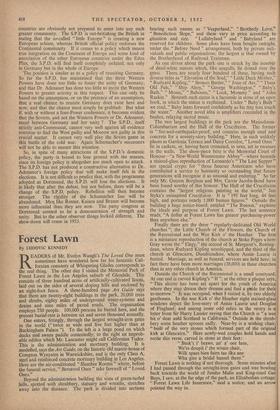Forest Lawn
By LUDOVIC KENNEDY
READERS of Mr. Evelyn Waugh's The Loved One must sometimes have wondered how far his fantastic Cali- fornian cemetery of Whispering Glades corresponds to the real thing. The other day I visited the Memorial Park of Forest Lawn in the Los Angeles suburb of Glendale. This consists of three hundred acres of artificially-cultivated lawns, laid out on the sides of several sloping hills and enclosed by an eight-foot fence. A three-hundred page Art Guide says that there are twenty-eight buildings in the park, 20,000 trees and shrubs, eighty miles of underground water-systems and drains and nine miles of paved roads. The organisation employs 750 people. 100,000 persons lie buried here, and the present burial-rate is between six and seven thousand annually. One enters, fittingly, through the largest wrought-iron gates in the world (" twice as wide and five feet higher than at Buckingham Palace "). To the left is a large pond on which ducks and swans paddle contentedly; to the right an improb- able edifice which Mr. Lancaster might call Californian Tudor. This is the administration and mortuary building. It is modelled, says the Art Guide, on the historic old manor-house of Compton Wynyates in Warwickshire, and is the only Class A, steel and reinforced concrete mortuary building in Los Angeles. Here are the air-conditioned " Slumber Rooms " where, before the funeral service, " Bereaved Ones " take farewell of " Loved.. Ones." Beyond the administration building the vista of green-turfed hills, spotted with shrubbery, statuary and wreaths, stretches away into the distance. The park is divided into sections bearing such names as " Vesperland," " Brotherly Love," " Benediction Slope," and these vary in price according to .situation and size. " Lullabyland " and " Babyland " are reserved for children. Some plots have been bought outright, under the " Before Need " arrangement, both by private indi- viduals and public organisations; the largest is that owned by the Brotherhood of Railroad Trainmen.
As one drives about the park one is struck by the number of dead-white statues which, like seagulls, lie dotted over the grass. There are nearly four hundred of these, having such diverse titles as " Elevation of the Soul," " Little Duck Mother," " Rudyard Kipling," " Bronco Buster," " Joan of Arc," " Three Old Pals," " Ship Ahoy," " George Washington," " Baby's Bath," Moses," Baboons," " Look, Mommy" and " John Ruskin." Beneath each statue is a facsimile in stone of an open book, in which the statue is explained. Under " Baby's Bath " we read, " Baby leans forward confidently as his tiny toes touch the water." Another novel idea is amplifiers concealed in the bushes, relaying sacred music.
The two largest buildings in the park are the Mausoleum- Columbarium and the Hall of the Crucifixion. The former is " fire-and-earthquake-proof,, and contains enough steel and concrete for a seventy-story building." Here, in such unlikely places as Gardenia Terrace and Daisy Corridor, " Loved Ones ' lie in caskets, or, having been cremated, in urns, set in recesses in the walls. The show-piece here is the Memorial Court of Honour—"a New-World Westminster Abbey"—where beneath a stained-glass reproduction of Leonardo's " The Last $upper " are special crypts for " those famous Americans who have contributed a service to humanity so outstanding that future generations will recognise it as unusual and enduring." So far only Mr. Gutzon Borglum and Mrs. Carrie Jacobs-Bond have been found worthy of this honour. The Hall of the Crucifixion contains the "largest religious painting in the world," Jan Styka's uninspired Crucifixion. It is " 195 feet long, 44 feet high, and portrays nearly 1,000 human figures." Outside the building a huge notice-board, entitled " The Reason," explains the ideals and purpose of Forest Lawn. The last sentence reads, "A dollar at Forest Lawn has greater purchasing-power than anywhere else."
Finally there are the three " regularly-dedicated Old World churches "; the Little Church of the Flowers, the Church of the Recessional and the Wee Kirk o' the Heather. The first is a miniature reproduction of the church at Stoke Poges where Gray wrote the Elegy," the second of St. Margaret's, Rotting- dean, where Rudyard Kipling worshipped, and the third of the church at Glencairn, Dumfriesshire, where Annie Laurie is buried. Marriage, as well as funeral, services are held here; in fact there have been more marriages•(38,000) in these churches than in any other church in America.
Outside the Church of the Recessional is a small courtyard. At one end is carved Kipling's " If "; at the other a plaque says, " This alcove has been set apart for the youth of America where they may dream their dreams and find a pride for their to-morrow." It was occupied, when I visited it, by two elderly gentlemen. In the wee Kirk o' the Heather eight stained-glass windows depict the love-story of Annie Laurie and Douglas of Fingland; and among some odd relics in the vestry is a letter from Sir Harry Lauder saying that the Church is " a wee bit o' dear auld Scotland in California." Outside in the shrub- bery some heather sprouts sadly. Near-by is .a wishing chair, " built of the very stones which formed part of the original kirk at Glencairn." Here newly-wed couples hold hands and recite this verse, carved in stone at their feet: " Busk't braws, an' a' oor lane, We're doupit i' the wissin chair, Wilk spaes bien fairn tae ilka ane Wha gies a bridal hansel there."
Forest Lawn is nothing if not thorough. Some minutes after I had passed through the wrought-iron gates and was bowling back towards the world of Jumbo Malts and King-sized Gas Buys, I saw, at the far edge of the park, an Elizabethan cottage. " Forest Lawn Life Insurance," said a notice; and an arrow pointed the way in.


















































 Previous page
Previous page